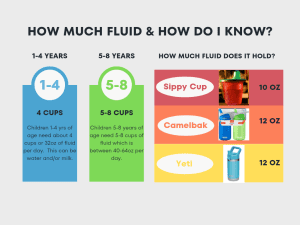It’s hot!! And the heat is here to stay, with KSAT News predicting that this year San Antonio will beat its record for the most 100-degree days. But we love summer and we need our kids to stay active and play outside. We also need them to be safe! Let’s talk about heat-related illness so our kids can play safely during this crazy hot summer.
Heat Illness
Blatantly put, heat illness is when our body temperature gets too high. The fancier medical word for this is hyperthermia, which is defined as a body temperature above 99.5°F. This overheating is due to environmental factors and a failure of our body’s thermoregulation. Our body temperature is affected by multiple factors—air temperature, humidity, activity level, clothing, and more.
Kids are more susceptible to heat illness for a few reasons—they aren’t good at self-monitoring and verbalizing early warning signs including headache and thirst. Also, kids have a greater surface area body to mass ratio which makes them gain heat more quickly compared to adults. In easy-to-understand terms, this means that kids aren’t very good at telling us when they are thirsty or have a headache AND they have a lot of skin exposed to the sun compared to their body weight. Put these two factors together, and we have a kiddo susceptible to heat illness. Living in South Texas, the humidity also increases the risk of heat-related illness—high humidity levels make our sweating ineffective, and therefore body temperatures rise faster when you’re outside.
Let me make the distinction that heat illness is different from fever. Fever is part of the body’s immune response in which the body creates a temporary rise in body temperature. Heat illness is different from dehydration. Dehydration and heat illness often go together and contribute to one another, but you can have dehydration without heat illness and heat illness without dehydration.
If you are worried about heat illness in your child, you should not stop and attempt to take their temperature. To use body temperature as a diagnosis of heat illness, the temperature must be an internal or core temperature reading—something we can’t do when at soccer practice or the pool. We, as parents, should observe our children and note their symptoms rather than try to take their temperature.
Heat Cramps
Heat illness ranges from mild to severe. The first and mildest form of heat-related illness is heat cramps. Heat cramps are painful and involuntary muscle spasms caused by increased heat, dehydration, and loss of nutrients/fluid from our body. Heat cramps are typically caused by prolonged or excessive sweating and usually occur in our arms, legs, abdomen, and back. In other words, this is when a muscle unexpectedly and rapidly contracts and stays contracted. This hurts A LOT! These cramps cause kids (and adults) to yell and/or fall to the ground. Cramps can start off mildly and feel like a pang of stomach or back pain, but the cramps will increase in severity and duration if activity is not reduced or attempts are not made to cool off the person. Untreated cramps will also progress to heat exhaustion.
Heat Exhaustion
Heat exhaustion is when our body’s cooling mechanisms are not working to maintain temperature and our body temperature rises to between 100°F and 104°F. But more important than a specific temperature is symptom observation. Weakness, fatigue, irritability, muscle cramps, nausea, and increased thirst are all symptoms of heat exhaustion.
Heat Stroke
Heat stroke is the most severe form of heat illness and is a medical emergency. Heat stroke is defined as body temperature above 105°F. Symptoms are easily recognizable and severe such as vomiting, rapid breathing, and altered mental state such as confusion, delirium, and/or loss of consciousness. Prolonged and untreated heat stroke will cause damage to major organs including kidneys, heart, and brain. Treatment at a hospital will include rapidly, but safely, lowering body temperature.
Staying Safe in the Heat
But our kids need to go outside!! (My three daughters start to go stir crazy and everyone gets irritable when stuck inside, including Mom and Dad!)
So how do we recognize when kids need a break?
Here is an easy look at what is normal and what is not—again, as parents, we want to observe the symptoms and overall condition of our child. Any time kids are in the heat we need to schedule breaks and plan for hydration—keep reading for amounts and tips. “Normal” means things that happen when a healthy kid is in the heat or being active in the heat. The “normal” symptoms are not warning signs or reasons for concern. If ANY abnormal symptoms are present, activity needs to be stopped immediately.
| Normal and Abnormal Symptoms to Look For: | ||
| Normal | Abnormal
(Heat Exhaustion) |
Abnormal (Heat Stroke) |
|
|
|
What to do?
Again, if any of the above abnormal symptoms are present, or if you are concerned about your child, all activity needs to stop immediately. Move the child to a shaded place or preferably an air-conditioned space. If the child’s clothes are wet/sweaty, remove their clothes to allow for easier cooling. Give frequent sips of cool, clear liquids. With these measures, the child should start to improve quickly, roughly within 30 minutes. If you do not see improvement, the child needs medical attention and you should consider whether the child has heat stroke. After mild symptoms for at least the next 24 hours, let the child primarily rest and avoid the sun or hot environments.
Hydration in the Heat
Let’s start with the basics related to hydration. Kids need to drink water every day and need to drink more during and after playing in the heat. Keeping our kids hydrated is important and at times a chore—I grow tired of nagging my kids to drink. So how can we get our tiny (or medium-sized) humans to drink their water?!?

- Let your kid pick out funny straws or cups to use at home with their water.
- Feed them water by providing chilled fresh fruits and vegetables.
- Sports drinks are okay for kids who have been active and sweating outside.
- Add flavor.
- If kids won’t drink water, start by diluting their juice with water and aim for an end goal of 30% juice to 70% water.
All of these things still require work but are hopefully more effective and less energy-draining than nagging.
Tell us in the comments…
What tricks do you use to keep your kids hydrated?
How much and what to drink?

The American Academy of Pediatrics recommends four cups, or 32 ounces, per day for kids one to four years. For slightly older kids, five to eight years old, five to eight cups, or 40 to 64 ounces, is recommended. For kids older than eight, 64 ounces of total daily fluid intake is the recommendation. IN ADDITION, add one cup for every hour that kids spend being active inside or outside.
All beverages count toward our daily total. Certain drinks, such as water and diluted juice/sports drinks, are more hydrating than others and sugary drinks should be limited. Sports drinks are only recommended for children when they have been active and sweating to help replace electrolytes lost through sweating and still should not make up the majority of fluid intake.
Let’s Beat the Heat!
We can survive this never-ending heat! I push my kids out the door early in the morning and again late in the day and help them stay hydrated all day. Frequent application of sunscreen also helps avoid heat illness because damaged skin will lose fluid faster. Also keep in mind that it only takes 20 minutes for kids to begin to reach dangerous internal body temperatures—so make those breaks frequent and filled with cool drinks. Look for other Alamo City Moms articles with ideas to beat the heat, including playgrounds with splash pads, the best swimming spots within driving distance, and The Ultimate Guide to Ice Cream in San Antonio! Happy summer!











